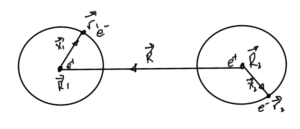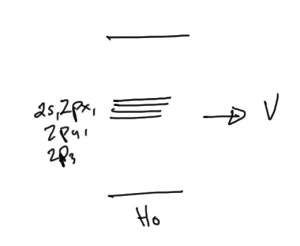[Click here for a PDF of this post with nicer formatting]
Q: [1] pr 5.16
For a particle in a spherically symmetric potential \( V(r) \) show that
\begin{equation}\label{eqn:symmetricPotentialDerivativeExpectation:20}
\Abs{\psi(0)}^2 = \frac{m}{2 \pi \Hbar^2} \expectation{ \frac{dV}{dr} },
\end{equation}
for all s-states, ground or excited.
Then show this is the case for the 3D SHO and hydrogen wave functions.
A:
The text works a problem that looks similar to this by considering the commutator of an operator \( A \), later set to \( A = p_r = -i \Hbar \PDi{r}{} \) the radial momentum operator. First it is noted that
\begin{equation}\label{eqn:symmetricPotentialDerivativeExpectation:40}
0 = \bra{nlm} \antisymmetric{H}{A} \ket{nlm},
\end{equation}
since \( H \) operating to either the right or the left is the energy eigenvalue \( E_n \). Next it appears the author uses an angular momentum factoring of the squared momentum operator. Looking earlier in the text that factoring is found to be
\begin{equation}\label{eqn:symmetricPotentialDerivativeExpectation:60}
\frac{\Bp^2}{2m}
= \inv{2 m r^2} \BL^2 – \frac{\Hbar^2}{2m} \lr{ \PDSq{r}{} + \frac{2}{r} \PD{r}{} }.
\end{equation}
With
\begin{equation}\label{eqn:symmetricPotentialDerivativeExpectation:80}
R = – \frac{\Hbar^2}{2m} \lr{ \PDSq{r}{} + \frac{2}{r} \PD{r}{} }.
\end{equation}
we have
\begin{equation}\label{eqn:symmetricPotentialDerivativeExpectation:100}
\begin{aligned}
0
&= \bra{nlm} \antisymmetric{H}{p_r} \ket{nlm} \\
&= \bra{nlm} \antisymmetric{\frac{\Bp^2}{2m} + V(r)}{p_r} \ket{nlm} \\
&= \bra{nlm} \antisymmetric{\inv{2 m r^2} \BL^2 + R + V(r)}{p_r} \ket{nlm} \\
&= \bra{nlm} \antisymmetric{\frac{-\Hbar^2 l (l+1)}{2 m r^2} + R + V(r)}{p_r} \ket{nlm}.
\end{aligned}
\end{equation}
Let’s consider the commutator of each term separately. First
\begin{equation}\label{eqn:symmetricPotentialDerivativeExpectation:120}
\begin{aligned}
\antisymmetric{V}{p_r} \psi
&=
V p_r \psi
–
p_r V \psi \\
&=
V p_r \psi
–
(p_r V) \psi
–
V p_r \psi \\
&=
–
(p_r V) \psi \\
&=
i \Hbar \PD{r}{V} \psi.
\end{aligned}
\end{equation}
Setting \( V(r) = 1/r^2 \), we also have
\begin{equation}\label{eqn:symmetricPotentialDerivativeExpectation:160}
\antisymmetric{\inv{r^2}}{p_r} \psi
=
-\frac{2 i \Hbar}{r^3} \psi.
\end{equation}
Finally
\begin{equation}\label{eqn:symmetricPotentialDerivativeExpectation:180}
\begin{aligned}
\antisymmetric{\PDSq{r}{} + \frac{2}{r} \PD{r}{} }{ \PD{r}{}}
&=
\lr{ \partial_{rr} + \frac{2}{r} \partial_r } \partial_r
–
\partial_r \lr{ \partial_{rr} + \frac{2}{r} \partial_r } \\
&=
\partial_{rrr} + \frac{2}{r} \partial_{rr}
–
\lr{
\partial_{rrr} -\frac{2}{r^2} \partial_r + \frac{2}{r} \partial_{rr}
} \\
&=
-\frac{2}{r^2} \partial_r,
\end{aligned}
\end{equation}
so
\begin{equation}\label{eqn:symmetricPotentialDerivativeExpectation:200}
\antisymmetric{R}{p_r}
=-\frac{2}{r^2} \frac{-\Hbar^2}{2m} p_r
=\frac{\Hbar^2}{m r^2} p_r.
\end{equation}
Putting all the pieces back together, we’ve got
\begin{equation}\label{eqn:symmetricPotentialDerivativeExpectation:220}
\begin{aligned}
0
&= \bra{nlm} \antisymmetric{\frac{-\Hbar^2 l (l+1)}{2 m r^2} + R + V(r)}{p_r} \ket{nlm} \\
&=
i \Hbar
\bra{nlm} \lr{
\frac{\Hbar^2 l (l+1)}{m r^3} – \frac{i\Hbar}{m r^2} p_r +
\PD{r}{V}
}
\ket{nlm}.
\end{aligned}
\end{equation}
Since s-states are those for which \( l = 0 \), this means
\begin{equation}\label{eqn:symmetricPotentialDerivativeExpectation:240}
\begin{aligned}
\expectation{\PD{r}{V}}
&= \frac{i\Hbar}{m } \expectation{ \inv{r^2} p_r } \\
&= \frac{\Hbar^2}{m } \expectation{ \inv{r^2} \PD{r}{} } \\
&= \frac{\Hbar^2}{m } \int_0^\infty dr \int_0^\pi d\theta \int_0^{2 \pi} d\phi r^2 \sin\theta \psi^\conj(r,\theta, \phi) \inv{r^2} \PD{r}{\psi(r,\theta,\phi)}.
\end{aligned}
\end{equation}
Since s-states are spherically symmetric, this is
\begin{equation}\label{eqn:symmetricPotentialDerivativeExpectation:260}
\expectation{\PD{r}{V}}
= \frac{4 \pi \Hbar^2}{m } \int_0^\infty dr \psi^\conj \PD{r}{\psi}.
\end{equation}
That integral is
\begin{equation}\label{eqn:symmetricPotentialDerivativeExpectation:280}
\int_0^\infty dr \psi^\conj \PD{r}{\psi}
=
\evalrange{\Abs{\psi}^2}{0}{\infty} – \int_0^\infty dr \PD{r}{\psi^\conj} \psi.
\end{equation}
With the hydrogen atom, our radial wave functions are real valued. It’s reasonable to assume that we can do the same for other real-valued spherical potentials. If that is the case, we have
\begin{equation}\label{eqn:symmetricPotentialDerivativeExpectation:300}
2 \int_0^\infty dr \psi^\conj \PD{r}{\psi}
=
\Abs{\psi(0)}^2,
\end{equation}
and
\begin{equation}\label{eqn:symmetricPotentialDerivativeExpectation:320}
\boxed{
\expectation{\PD{r}{V}}
= \frac{2 \pi \Hbar^2}{m } \Abs{\psi(0)}^2,
}
\end{equation}
which completes this part of the problem.
A: show this is the case for the 3D SHO and hydrogen wave functions
For a hydrogen like atom, in atomic units, we have
\begin{equation}\label{eqn:symmetricPotentialDerivativeExpectation:360}
\begin{aligned}
\expectation{
\PD{r}{V}
}
&=
\expectation{
\PD{r}{} \lr{ -\frac{Z e^2}{r} }
} \\
&=
Z e^2
\expectation
{
\inv{r^2}
} \\
&=
Z e^2 \frac{Z^2}{n^3 a_0^2 \lr{ l + 1/2 }} \\
&=
\frac{\Hbar^2}{m a_0} \frac{2 Z^3}{n^3 a_0^2} \\
&=
\frac{2 \Hbar^2 Z^3}{m n^3 a_0^3}.
\end{aligned}
\end{equation}
On the other hand for \( n = 1 \), we have
\begin{equation}\label{eqn:symmetricPotentialDerivativeExpectation:380}
\begin{aligned}
\frac{2 \pi \Hbar^2}{m} \Abs{R_{10}(0)}^2 \Abs{Y_{00}}^2
&=
\frac{2 \pi \Hbar^2}{m} \frac{Z^3}{a_0^3} 4 \inv{4 \pi} \\
&=
\frac{2 \Hbar^2 Z^3}{m a_0^3},
\end{aligned}
\end{equation}
and for \( n = 2 \), we have
\begin{equation}\label{eqn:symmetricPotentialDerivativeExpectation:400}
\begin{aligned}
\frac{2 \pi \Hbar^2}{m} \Abs{R_{20}(0)}^2 \Abs{Y_{00}}^2
&=
\frac{2 \pi \Hbar^2}{m} \frac{Z^3}{8 a_0^3} 4 \inv{4 \pi} \\
&=
\frac{\Hbar^2 Z^3}{4 m a_0^3}.
\end{aligned}
\end{equation}
These both match the potential derivative expectation when evaluated for the s-orbital (\( l = 0 \)).
For the 3D SHO I verified the ground state case in the Mathematica notebook sakuraiProblem5.16bSHO.nb
There it was found that
\begin{equation}\label{eqn:symmetricPotentialDerivativeExpectation:420}
\expectation{\PD{r}{V}}
= \frac{2 \pi \Hbar^2}{m } \Abs{\psi(0)}^2
= 2 \sqrt{\frac{m \omega ^3 \Hbar}{ \pi }}
\end{equation}
References
[1] Jun John Sakurai and Jim J Napolitano. Modern quantum mechanics. Pearson Higher Ed, 2014.



